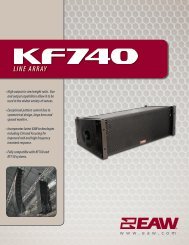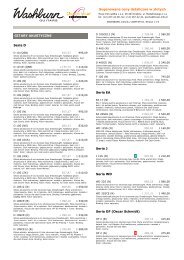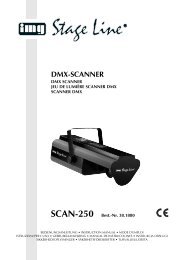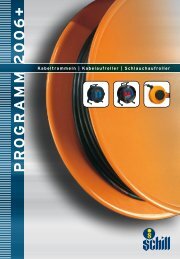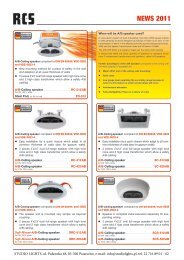Part - Studio Lights
Part - Studio Lights
Part - Studio Lights
You also want an ePaper? Increase the reach of your titles
YUMPU automatically turns print PDFs into web optimized ePapers that Google loves.
KNOW-HOW ›PRO-SOUND‹ TECHNOLOGY<br />
General introduction into professional sound systems<br />
The following tips, explanations and illustrations intend to facilitate the planning<br />
and thus the selection of PA sound systems for you.<br />
Planning of sound systems:<br />
Before the actual definition of an acoustic irradiation conception, basic information has<br />
to be acquired. Insufficient data would lead to making a customer-oriented planning<br />
nearly impossible. This often results in costly amendments after the installation took<br />
place, in order to ensure the actually desired utilisation. It is therefore basically reasonable<br />
to obtain extensive information serving as a foundation for every acoustic irradiation<br />
conception.<br />
Important fundamental information:<br />
1. Architecture (installation possibilities)<br />
● Where can speaker systems be placed and mounted<br />
respectively?<br />
● Are there any line-of-sight obstructions to be considered?<br />
● How heavily can the hanging spots be stressed?<br />
● Are there any objects in the room that may influence<br />
the sound projection negatively (e.g. low-hanging illuminants)?<br />
2. Optical integration<br />
● Are there any limitations concerning the selection of<br />
speaker systems in terms of dimension, colour, etc.?<br />
● Have the loudspeaker systems to be hidden behind<br />
the panelling, etc.?<br />
● Is it possible to inconspicuously implement the<br />
necessary cable ducts?<br />
3. Budget<br />
● How high is the purchase?<br />
● Is it possible to find out the size of the budget?<br />
Without information on the available budget, a precise<br />
planning is hardly feasible.<br />
Basic components of any sound system<br />
Every sound system is, in its simplest form, composed of a<br />
signal source, an amplifier and a loudspeaker. In order to<br />
improve the quality and to adapt to the relevant room, other<br />
audio components are integrated, depending on the tasks that<br />
have been set. According to circumstances and requirements,<br />
these components are systematically chosen and adjusted<br />
exactly to the room that is to be irradiated acoustically.<br />
Pro-Sound system<br />
Systems for high-performance acoustic irradiation in town<br />
halls, stadiums and arenas, which primarily serve for the<br />
transmission of music and orators, are called Pro-Sound<br />
systems.<br />
This kind of acoustic irradiation demands a great deal of the<br />
equal level distribution and the frequency response. In many<br />
projects, alarm system and high-performance acoustic irradiation<br />
are linked with each other for financial reasons. It is<br />
important, that in such cases the requirements of the EN<br />
60849 are applied to the whole system. Pro-Sound systems<br />
use low-impedance technology in order to achieve good<br />
transmission qualities in the bass range. Unlike 100 V PA<br />
systems, which only operate in MONO, Pro-Sound systems<br />
for the most part use STEREO. A stereo signal is sensibly<br />
used, only if at least two loudspeakers as well as two power<br />
amplifiers are supplied and if the listener is in an adequate<br />
position and distance to the speakers. Ideally, the listener<br />
should form an equilateral triangle with the loudspeakers<br />
(see fig. 1).<br />
4. Profile of requirements<br />
● What does the utilisation profile (focuses) of the<br />
sound system look like? Are there any specifications<br />
to be considered respectively?<br />
● Is the utilisation profile actually practicable in regard<br />
of the budget and/or the room´s nature? (e.g. “I´d like<br />
to have Hi-Fi sound with 115 dB sound pressure in all<br />
places, but the loudspeakers can only be installed<br />
beneath the stage.”)<br />
LS 1<br />
Listener<br />
LS 2<br />
Fig. 1<br />
303



